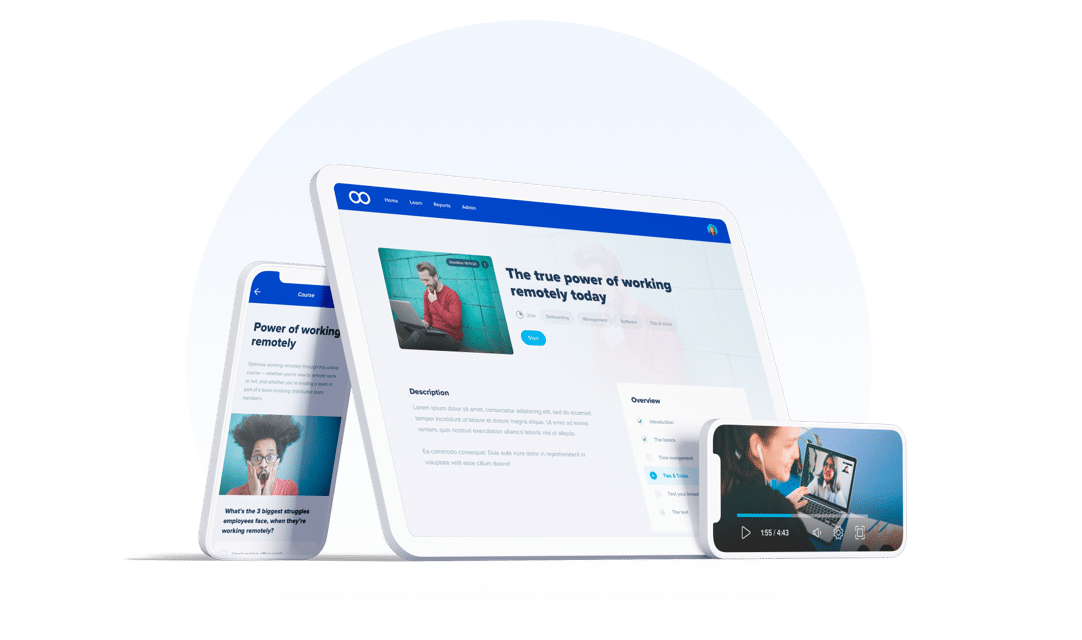Training academies and other corporate learning initiatives often mean comprehensive training modules that take up a lot of the employee’s time and give a disproportionate low learning output. Microlearning is the opposite: it’s quick to access on mobile devices, easy to digest and straight-to-the-point communication that is much easier to remember.
What is microlearning and why is it important?
Microlearning is small, focused learning modules that are delivered in bite-sized chunks. It is effective because it uses fast, frequent learning to teach employees what they need to know and when.
Microlearning modules fit seamlessly into the daily workflow of an organization, whether on a computer or via mobile learning, training can be accessed by employees at any time. Microlearning has been shown to be one of the most effective methods for employee training and development – even more effective than traditional eLearning.
Did you know that microlearning can decrease course development cost by 50% and increase the speed by 300%? As an LXP, eloomi makes microlearning easy by instantly delivering on-demand lessons based on the needs of each employee. Our platform is a powerful tool for online training and development that is easy to use, scalable, and affordable.
eloomi is an easy way for organizations to create and deliver microlearning courses that can be accessed anytime from anywhere by employees, partners, or customers.

Benefits of Microlearning
Microlearning makes your employees more productive, as they only have to spend time on the training they need, when they need it. This level of flexibility means that you can release a variety of educational modules over time in smaller chunks with shorter intervals between them, then review the feedback and make changes as needed.
Also, because microlearning content is accessible anywhere and at any time via the internet or mobile devices and apps, you can increase knowledge retention by giving employees the opportunity to engage with their training content right away (instead of waiting until the next scheduled training).
An LMS (Learning Management System) naturally enhances the effectiveness of microlearning by centralizing all training materials, making it easier to manage and distribute these bite-sized modules. With an LMS, you can assess performance through integrated quizzes or assessments and update content in real-time based on feedback. This ensures that microlearning within your LMS is not only more flexible and personalized but also more efficient, as employees can access the specific training they need, precisely when they need it. With the advent of microlearning, people don’t have to sit through lengthy training courses anymore.
Microlearning needs to be kept simple. The shorter and more focused the better. To make your microlearning effective, combine only a few elements, e.g.:
- A 60-90 seconds video that positions the theme – could be a simple animation or a presenter explaining the subject.
- A short article or a few brief presentation slides giving insight, tips & tricks on how to improve something or guiding points that make it easier for employees to become compliant with your process or policy.
- A multiple choice test or some other way to validate comprehension. This will also give you valuable input about skill gaps in your organization, and where you might need to update training materials.
7 Microlearning Examples Learners Should Try
As trainers, It is important to know the importance of how microlearning can affect the individual’s growth. Here are some key examples and microlearning strategies to keep in mind that both learners and trainers should try:
1. Employee onboarding
Employee onboarding is one of the best microlearning examples because it is designed to help employees understand what their new job entails, and how to be successful. It’s also done in small pieces or nuggets—usually over several days—meaning employees can learn at their own pace, and on their own schedule.
The benefit of microlearning is that it meets employees where they are; some people prefer video, some prefer text-based instruction, some want a recorded presentation, and others want a step-by-step guide through a series of actions themselves. This opens up possibilities for onboarding hybrid and remote teams, while getting new employees up to speed faster and more efficiently.
2. Business skills
Business skills can be a good fit for microlearning because they are often short videos and to the point since they help business people with practical things that can be done on the job. For example, courses about preventing workplace discrimination would likely include information about strategies to help managers speak out against what they see as discriminatory behavior.
That may not be the right solution for all situations, though, so another microlearning course could emphasize the importance of promoting diversity in a way that doesn’t disadvantage anyone. This makes microlearning best for business skills development and training sessions. eloomi not only offers integrated training, but also makes it easier to track skills growth and engagement to see how microlearning directly impacts your business.
3. Workplace essentials
Workplace essentials are short and fun microlearning lessons on workplace issues, like workplace safety and professional development that help learners improve their new skills. They keep learners engaged, allow you to tap into their drive for growth, and develop a culture of lifelong learning.
Workplace essentials are a great example of microlearning because they take 60-90 seconds to complete, are learning content that anyone can participate in, and highlight key skills or concepts. They help increase and improve the workflow of your organization while also boosting personal employee morale.
4. Compliance training
Compliance training aims to ensure that workplaces live up to legal requirements, from health and safety to data protection standards. With microlearning, you’re able to prepare learners for on-the-job situations. It’s effective because it teaches the knowledge, skills, and attitudes needed to get the job done. To make learning more impactful and efficient, microlearning that is brief, targeted, and actionable can be used as an alternative to longer courses.
One of the biggest benefits of compliance training is that it can be customized for any organization. Compliance training can also be designed to be delivered electronically so that learners can access it whenever they need it.
5. Alternative training methods
Alternative training methods, such as microlearning videos and multiple choice, are examples of microlearning. They are beneficial because they break up the coursework into pieces. The student can learn a single concept at a time and then move on to something else. This makes it easier for them to remember the material. Students can also choose how many times they want to review each piece of information before moving on to the next one.
Gamification with flashcards-induced learning also works well with topics like basic math or technical coding-related issues that must be mastered in order for students to successfully complete classes in other subjects involving complex problems.
6. Surveys and Quizzes
Surveys, quizzes and infographics can be an example of microlearning because they help by reinforcing ideas and concepts while also testing students. Surveys are a great way to engage students in conversation, discuss issues that are important, and promote learning.
Quizzes help learners test their knowledge of the topic being studied. In short, interactive microlearning is beneficial to help learners retain the material being studied for future reference, and also helps better learner engagement.
7. Cybersecurity
A great way to infuse cybersecurity training into the feedback loop is through microlearning. Because it’s shorter, it allows you to fit in more repetitions of important concepts. Microlearning also keeps learners engaged by pushing them to take action and make decisions in real-time.
Microlearning can be especially effective in the context of cybersecurity training because it forces learners to make decisions and take action. For example, you could create a microlearning cybersecurity course that has learners respond to a simulated phishing attack by clicking on one of three buttons: “No,” “Yes,” or “I don’t know”. This will provide a more practical approach to safety initiatives.

Keep this in mind when you make your microlearning content
Classroom training and common e-learning in many cases merely convert lengthy powerpoint slides into e-learning modules. But today’s workforce requires a much more agile learning model and mobile availability, even when you need to dive deep into a single subject.
Many eloomi customers find that microlearning is particularly fruitful when the training subject is about a wide-scale organizational initiative that employees need to receive without disturbing their ongoing tasks.
To optimize this process, utilizing a microlearning LMS can make it easy to execute, keep costs low and deliver strong learning results. If you want to ensure success, these are some important points you should pay attention to:
- Convert your existing content
You probably have a lot of relevant content already. But many employees are not spontaneously picking up information on chaotic intranets, complicated archives and overloaded blogs. Instead you can slice the relevant information into pieces that are manageable for your staff. So change your existing product information, training academies and strategy plans into fast track microlearning courses.
- Make microlearning content engaging
Tell a story or simply provide examples to make the essence of your message easier to remember. Once you activate the learner’s emotions you have access to their memory. We recommend a short 60-90 seconds video (presenter, animation or infographic).
- Don’t repeat, just shorten
The more extensive your content is the more you need to repeat your points. But the nice thing about microlearning is that the modules are brief and learners can easily revisit the content as often as they like.
- Use multimedia
Most people prefer video over any other media. So even if you like writing better, in reality your only option is to start using video to get through to your corporate audience. Luckily, it’s easy to shoot simple videos with your smartphone or record a screencast on your computer. See below examples of how you can get started with short and effective videos.
- Build knowledge and skills
We recommend building the microlearning using a 3-step approach: 1) a video, 2) supporting text, e.g. slides and 3) a short quiz. This way your learner will be able to instantly test her comprehension and show her where her knowledge is strong or needs repetition.
Choose eloomi for simplified microlearning
Even people with very good attention spans struggle to remain engaged and learn new things. eloomi makes it easy to create microlearning courses in minutes. Discover and start creating microlearning content courses that comply with your company’s HR needs, and distribute them wherever learners need them most.
With simple and intuitive drag and drop microlearning tools, you can easily create engaging microlearning content. Craft learning experiences that are just perfect for your audience as you publish and distribute your microlearning.
eloomi offers a powerful platform for microlearning. It makes it easy to create, deliver and share content that your learners can learn from anywhere, anytime.
With a variety of courses in different formats, and availability even on smartphones, get your corporate training programs started with eloomi now!







